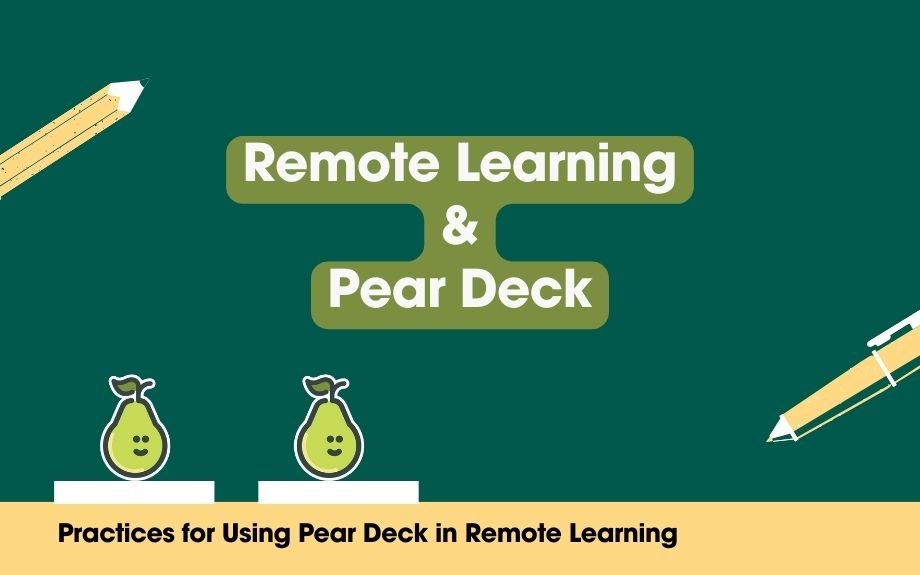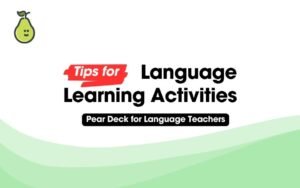In the era of virtual classrooms and distance learning, teachers around the world are constantly looking for innovative solutions to engage students and enhance the quality of online education.
One such solution receiving widespread praise is Pear Deck, a dynamic platform designed to transform static presentations into interactive and collaborative learning experiences. In this blog post, we will explore advanced strategies and best practices for harnessing the full potential of Pear Deck for an enriching remote learning journey.
Practices for Using Pear Deck in Remote Learning Environments
Getting ready to dive into the Pier Deck? very nice! Let’s talk about how you can take your lessons to the next level. Start by thinking about your students and what makes them tick.
What topics might encourage a little extra engagement? Perhaps it’s a complex concept that requires some interactive magic, or perhaps a discussion that could benefit from student input.
1. Strategic Lesson Planning
Strategically plan your slides. Consider where pier deck activities can fit seamlessly. Will the pullable question spark curiosity? Can a clickable feature add a layer of interaction at a specific point? By thinking ahead, you’ll easily integrate Pear Deck into your lessons, making it a natural part of the learning journey.
Remember, your goal is to make the learning experience enjoyable and effective. Pear Deck is your ally in achieving this, so take some time to consider how it can complement and enhance your lesson plans.
2. Dynamic Questioning Techniques
Okay, let’s talk questions! The heart of any good read lies in engaging and thought-provoking questions. With Pear Deck, you have a toolkit of interactive features – draggable points, clickable options, and more.
Consider learning objectives for your lesson. What questions might foster lively discussion or encourage critical thinking? Use Pear Deck’s dynamic features to create questions that go beyond the ordinary.
Turn a static concept into an interactive adventure, and watch your students dive into the material with enthusiasm.
Remember, the goal is not just to ask questions but to foster an environment where students actively participate in their learning. So, let those questions shine and invite your students to be a part of the educational journey.
3. Gamification for Engagement
Who said learning can’t be a game? Let us turn your Pear Deck presentations into an exciting educational playground. Gamification is a powerful tool to boost student motivation and participation.
Consider adding quizzes with a little competitive spirit. Create challenges that encourage friendly competition among your students. Interactive games not only make learning more enjoyable but also provide students with a unique opportunity to apply and reinforce what they have learned.
So, level up your lessons with Pear Deck gamification! It’s a win-win engaging learning experience that feels like a game.
4. Real-Time Collaboration
Foster a collaborative learning environment using Pear Deck’s real-time collaboration features. Encourage students to work together on group activities, share insights, and solve problems collectively.
The platform’s collaborative tools mimic traditional classroom interactions, fostering a sense of community among remote learners.
5. Personalized Learning Paths
Recognize the unique learning needs of individual students by incorporating personalized learning paths. Use Pear Deck’s features to provide additional resources or challenges based on student responses.
This tailored approach ensures that each student receives a learning experience that is tailored to their specific needs and abilities.
6. Extended Learning Opportunities
Extend learning beyond the virtual classroom by using Pear Deck for asynchronous activities. Assign interactive presentations as homework or supplemental material, allowing students to review and engage with the material at their own pace. This flexibility accommodates different learning schedules and preferences.
7. Incorporate Multimedia Rich Content
Enhance the visual appeal of your Pear Deck presentations by incorporating multimedia elements. Embed videos, images, and audio clips to cater to diverse learning styles.
A multimedia-rich approach not only captivates students’ attention but also reinforces key concepts through multiple sensory modalities.
8. Interactive Note-Taking
Take advantage of Pear Deck for interactive note taking. Encourage students to comment directly on the slides, highlighting key information or writing questions.
This not only promotes active participation but also provides students with a personalized study resource to refer to later.
9. Continuous Professional Development
Stay up to date on the latest Pear Deck features and instructional strategies by participating in continuing professional development.
Attend webinars, workshops, and training sessions to deepen your understanding of the platform’s capabilities. An expert teacher can effectively implement the Pear Deck to its full potential.
10. Feedback Loop for Improvement
Establish a feedback loop with your students to continually improve your Pear Deck presentations. Encourage students to provide feedback on the effectiveness of interactive elements and the overall learning experience. Use this input to refine your future lessons and ensure continued growth.
Final Words
As teachers look at the evolving landscape of distance learning, Pear Deck emerges as a versatile ally in creating dynamic and engaging virtual classrooms.
By adopting these advanced strategies and best practices, teachers can unlock the full potential of Pear Deck, fostering a collaborative and interactive learning environment that goes beyond the limitations of physical classrooms.
As we continue to explore innovative approaches to education, Pear Deck stands as an icon of innovation, empowering teachers to elevate the quality of remote learning experiences for students around the world.




